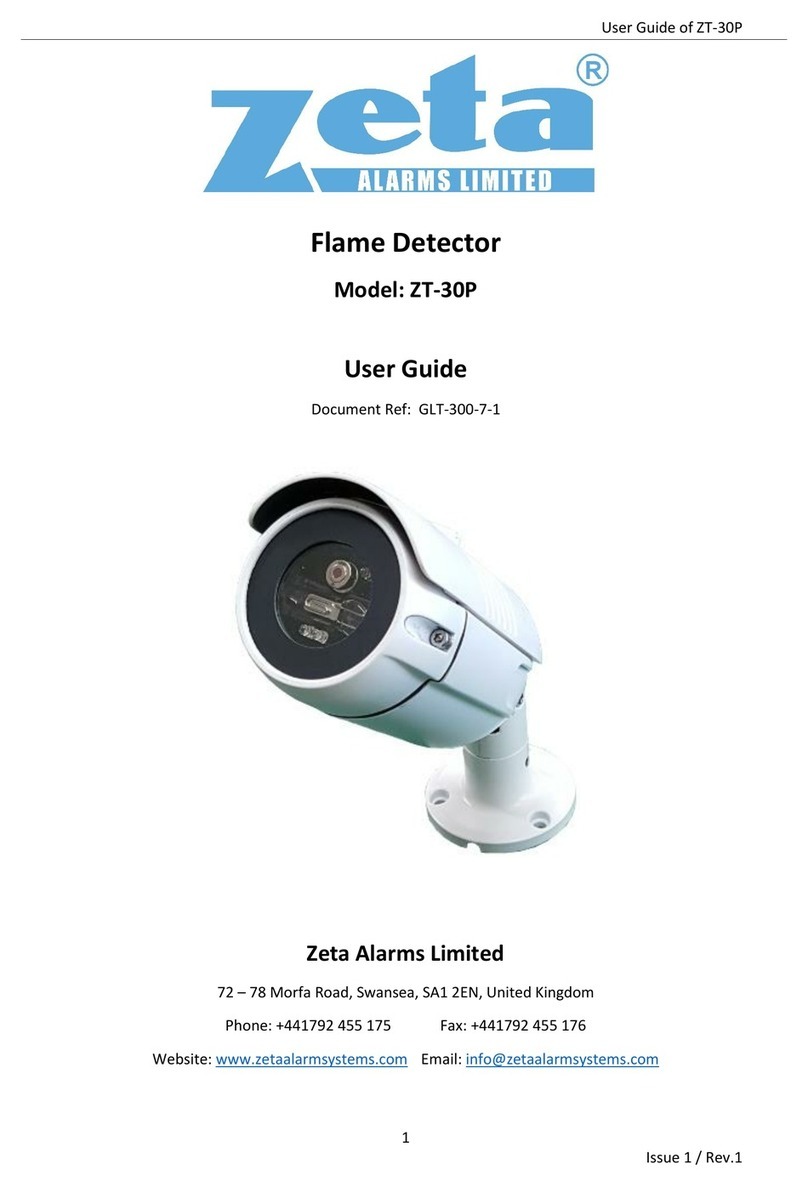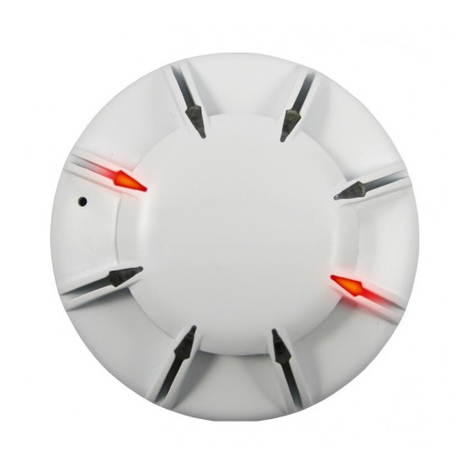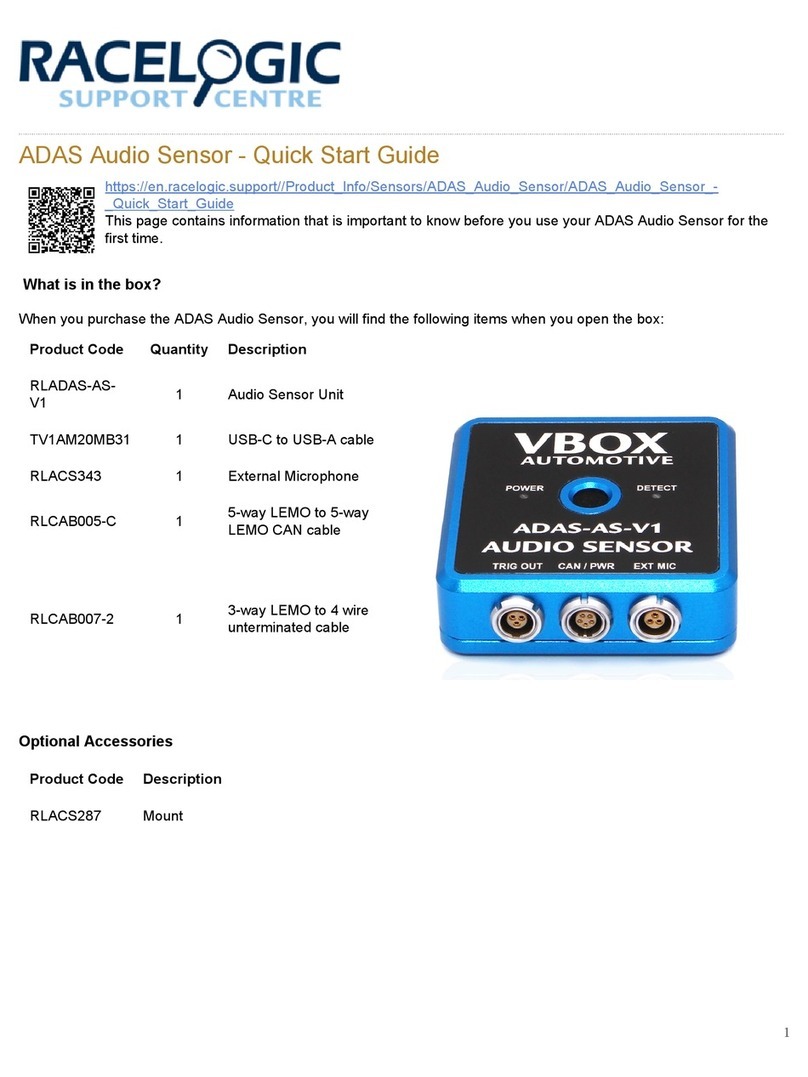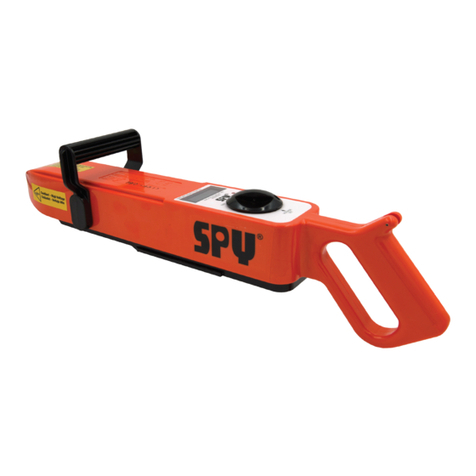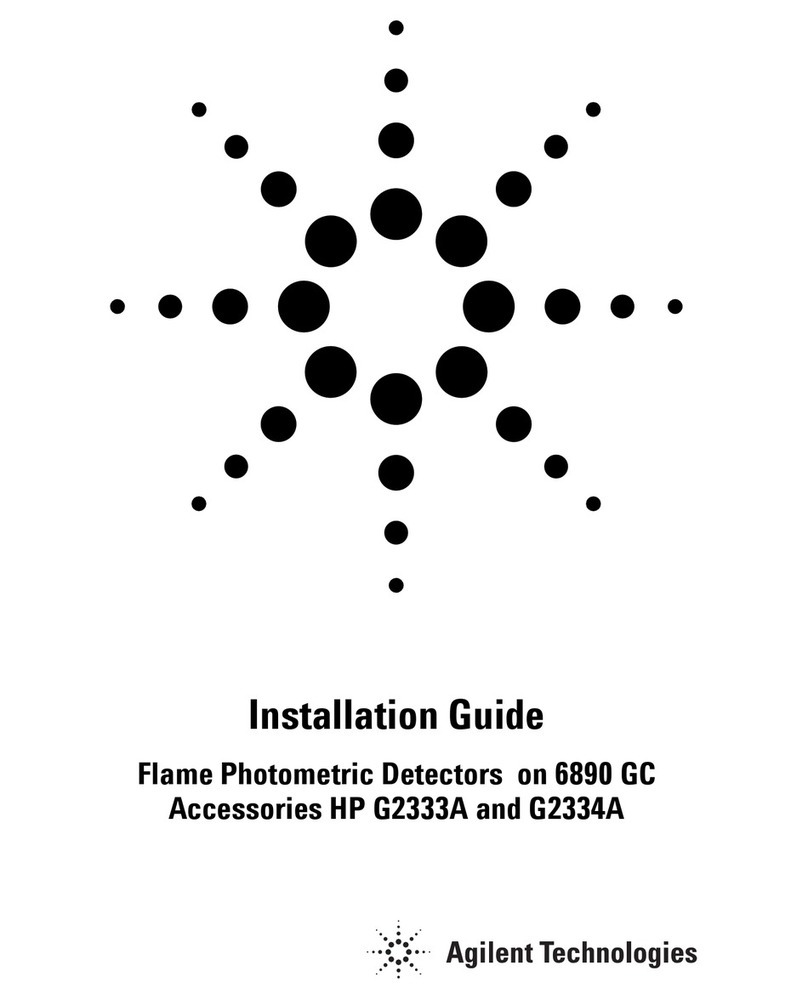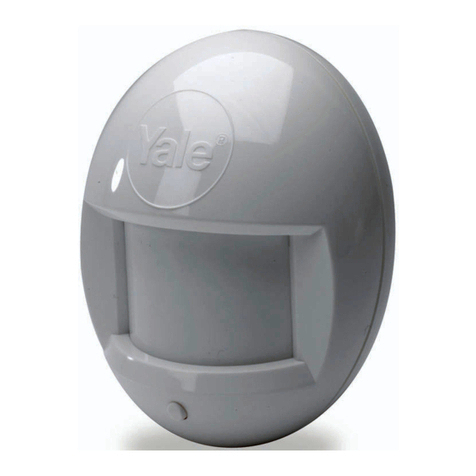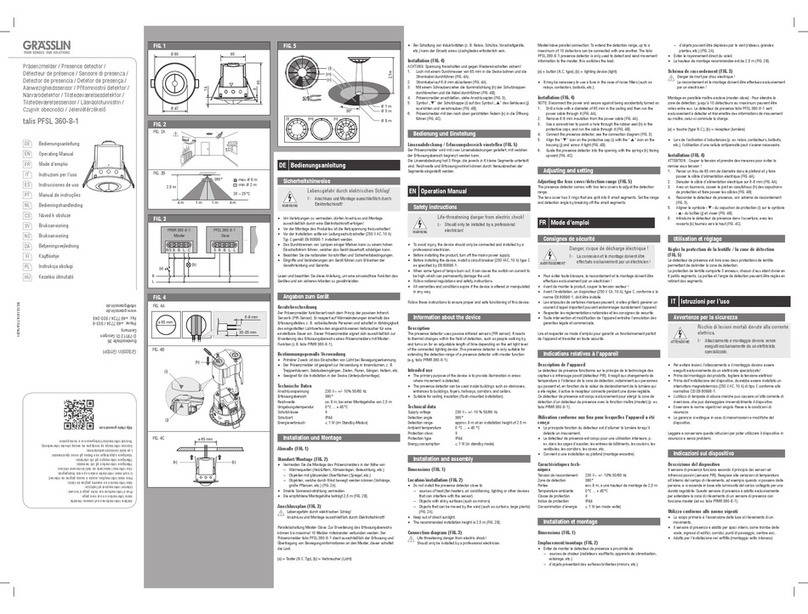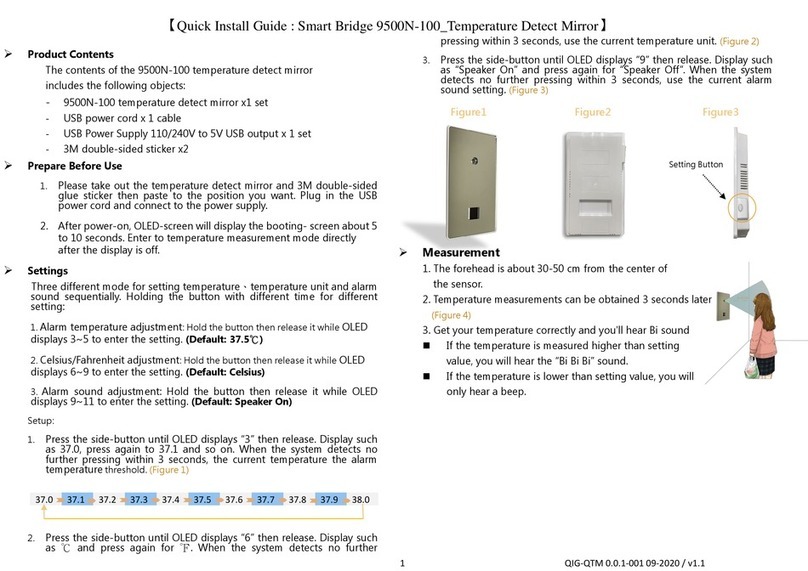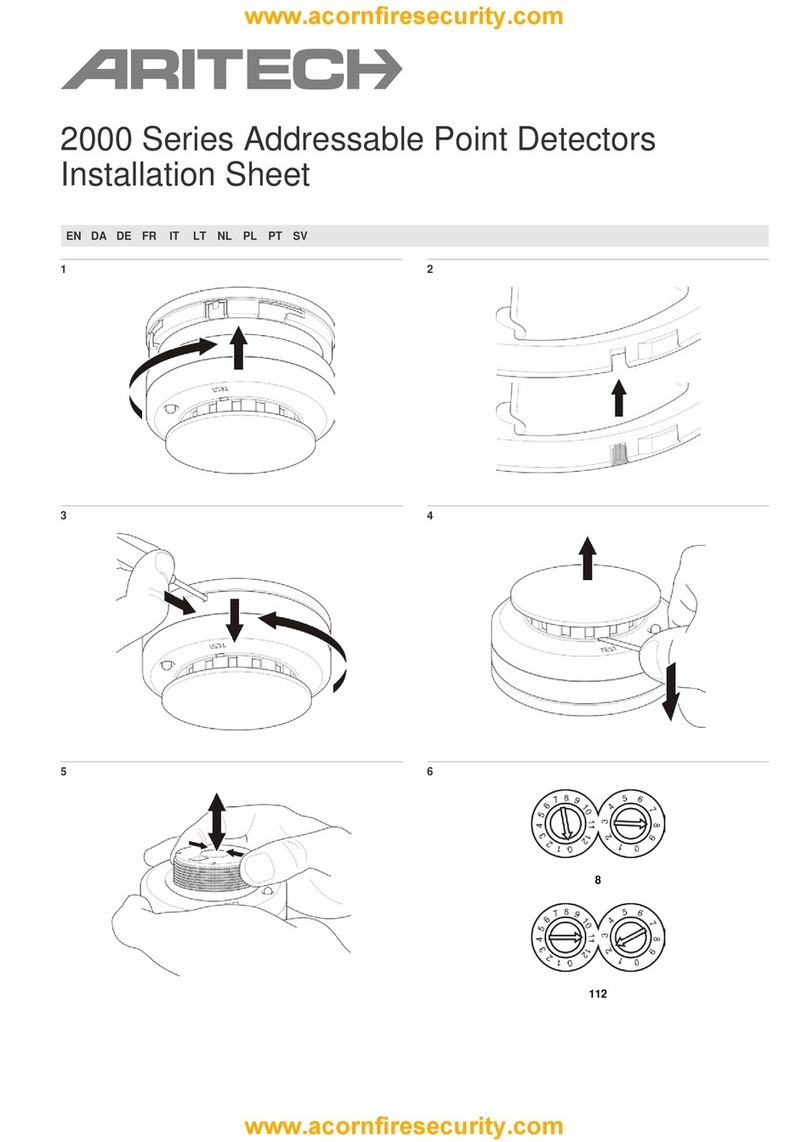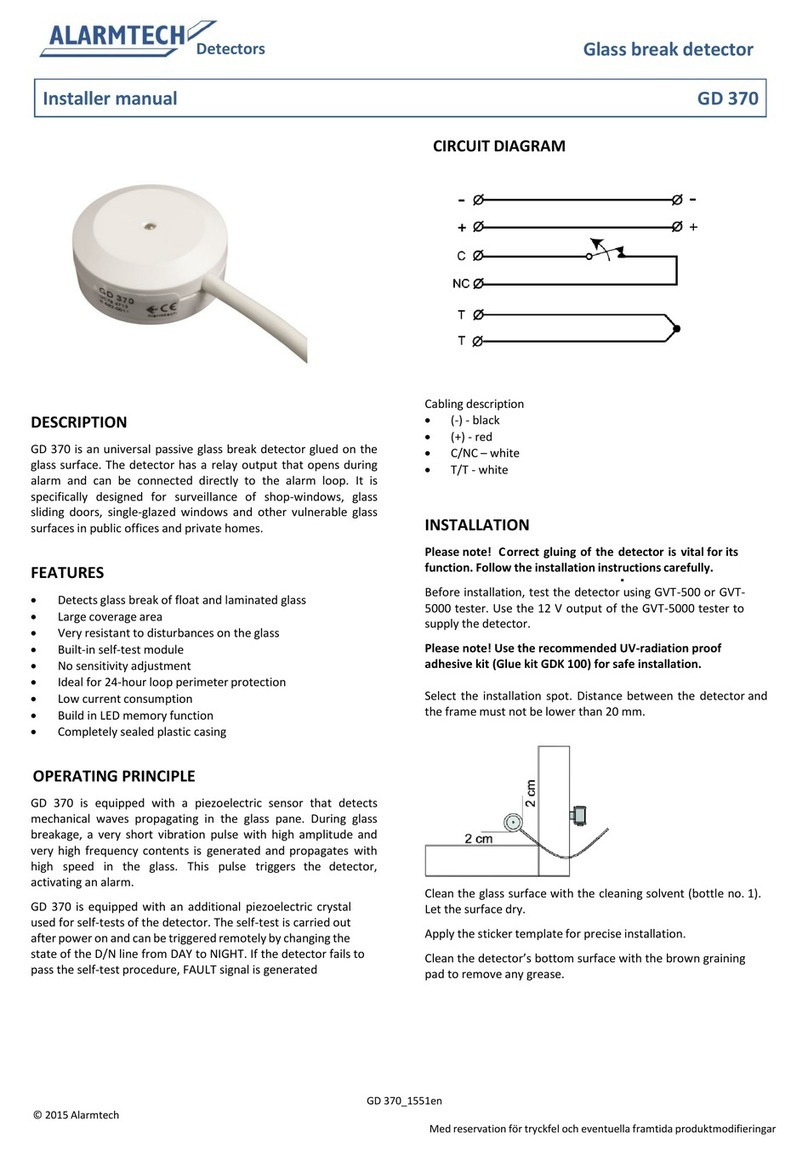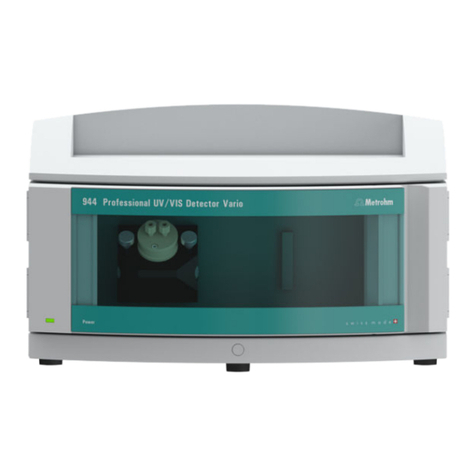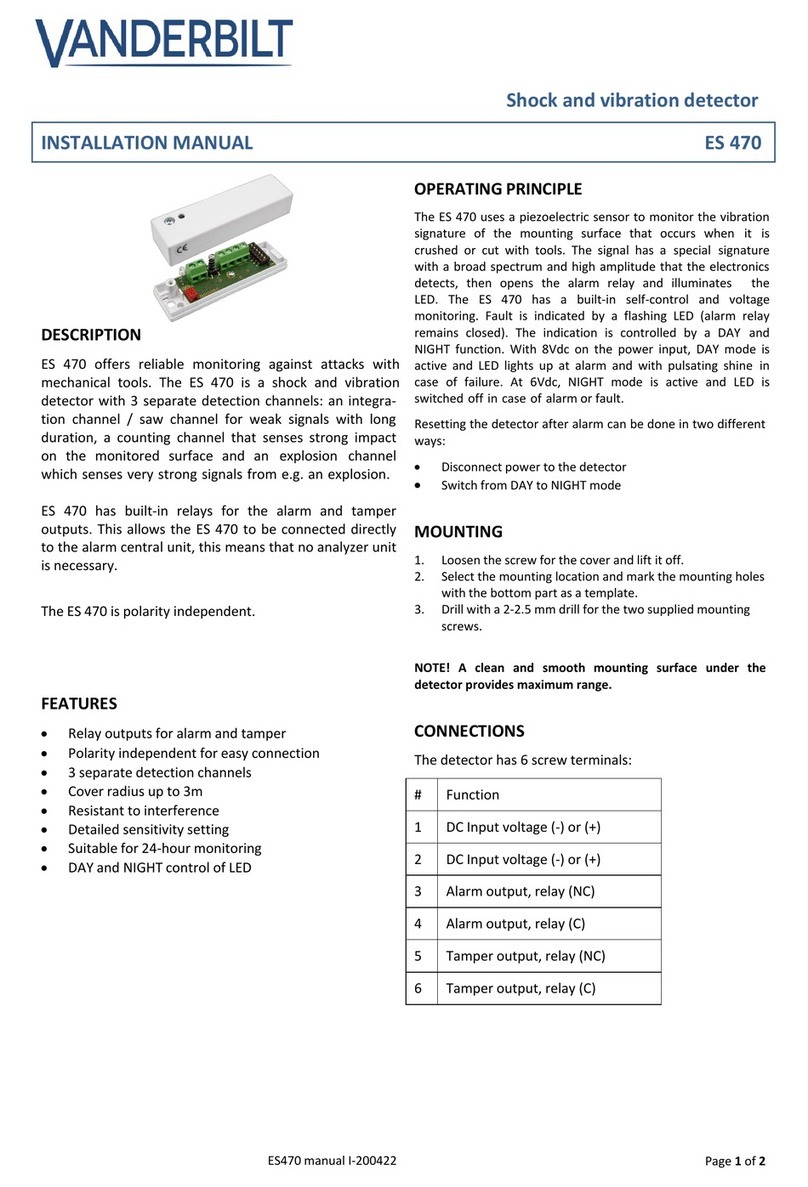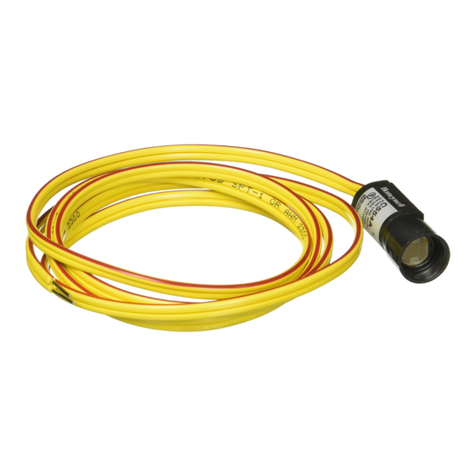Benning VT 1 User manual

BENNING VT 1
DBedienungsanleitung
Operating manual
FMode d‘emploi
Návodkpoužitízkoušečky
Käyttöohje
Οδηγίεςχρήσεως
IIstruzioniperl’uso
Gebruiksaanwijzing
Instrukcjaobsługi

BENNING VT 1
Mehrsprachige Anleitung unter
www.benning.de
Multilingual manuals at
DBedienungsanleitung
Operating manual
FMode d‘emploi
Gebruiksaanwijzing

05/ 2019
BENNING VT 1
3
D F I
A
2
1
3
4

05/ 2019
BENNING VT 1
4
D F I
230 V
AC
PE
N L
B
C

05/ 2019
BENNING VT 1
5
D
Bedienungsanleitung
BerührungsloserPhasen-undKabelbruchprüfer
BENNING VT 1
Bevor Sie den Phasen-/Kabelbruchprüfer BENNING VT 1 benutzen: Lesen Sie bitte die Bedienungs-
anleitung und beachten Sie unbedingt die Sicherheitshinweise!
1. Sicherheitshinweise:
- Unmittelbar vor und nach dem Benutzen den Phasen-/Kabelbruchprüfer auf Funktion prüfen!
(siehe Abschnitt 3). Das Gerät darf nicht benutzt werden, wenn die Funktion einer oder mehrerer
Anzeigen ausfällt oder keine Funktionsbereitschaft zu erkennen ist!
- Gerät beim Prüfen nur an dem roten Griff hinter der Griffbegrenzung 2anfassen und die weiße
Prüfspitze 1nicht berühren!
- Das Gerät darf nur im angegebenen Nennspannungsbereich von 200 V - 1000 V AC und in ge-
erdeten Netzstromkreisen der Überspannungskategorie CAT III 1000 V bzw. CAT IV 600 V Leiter
gegen Erde benutzt werden.
- Der Phasen-/Kabelbruchprüfer BENNING VT 1 erkennt Felder von Phasen-/Außenleiterspan-
nungen ab ca. 200 V Wechselspannung (AC). Felder von Gleichspannungen (DC) werden nicht
erkannt!
- Beachten Sie, dass Arbeiten an spannungsführenden Teilen und Anlagen grundsätzlich gefährlich
sind. Bereits Spannungen ab 30 V AC und 60 V DC können für den Menschen lebensgefährlich
sein.
- Mit dem Phasen- und Kabelbruchprüfer BENNING VT 1 kann nicht die Spannungsfreiheit von
einem Anlagenteil festgestellt werden; verwenden Sie dazu einen zweipoligen Spannungsprüfer,
z. B. DUSPOL®, um das Feststellen der Spannungsfreiheit zu bestimmen.
- Folgende Faktoren können die korrekte Funktionsweise der Phasen- und Kabelbruchprüfung ne-
gativ beeinflussen:
- zu großer Abstand zur prüfenden Phase (Außenleiter)
- zu starke Isolierung und Abschirmung der Phase (Außenleiter)
- Schutzkleidung und isolierende Standortgegebenheiten
- Konstruktive Unterschiede von Steckdosen/CEE-Kupplungen mit zurückliegenden Kontakten,
z.B. 63 A CEE-Kupplung
- Netzstörungen oder mangelnde Netzqualität
- Zustand der Batterien
- Gerät nicht mit geöffnetem Batterieschacht betreiben.
- Das Gerät ist für die Anwendung durch Elektrofachkräfte in Verbindung mit sicheren Arbeitsver-
fahren ausgelegt.
- Das Gerät ist vor Verunreinigungen und Beschädigungen der Gehäuseoberfläche zu schützen.
Elektrische Symbole auf dem Gerät:
Symbol Bedeutung
mAchtung Dokumentation beachten!
Das Symbol gibt an, dass die Hinweise in der Bedienungsanleitung zu beachten sind,
um Gefahren zu vermeiden

05/ 2019
BENNING VT 1
6
D
Dieses Symbol auf dem Gerät bedeutet, dass der BENNING VT 1 schutzisoliert
(Schutzklasse II) ausgeführt ist.
AC Wechselspannung
Erde (Spannung gegen Erde)
Dieses Symbol zeigt die Ausrichtung der Batterien zum polrichtigen Einlegen an
2. Gerätebeschreibung(Bild A)
1PrüfspitzemitLED-Anzeige (rot)
2Griffbegrenzung
3Clip
4Batteriefachdeckel
3. Funktionsprüfung
- Unmittelbar vor und nach dem Benutzen den Phasen-/Kabelbruchprüfer auf Funktion prüfen!
- Testen Sie die Funktion der Phasenprüfung an einer bekannten Spannungsquelle z.B. 230 V -
Steckdose/5-polige CEE Steckdose.
- Der Batteriewechsel ist erforderlich, wenn die rote LED-Anzeige 1oder der Signalton schwach
werden.
- Verwenden Sie den BENNING VT 1 nicht, wenn nicht alle Funktionen einwandfrei funktionieren!
- Der BENNING VT 1 besitzt keinen Ausschalter und ist immer aktiv. Eine spezielle Schaltung mit
geringer Stromaufnahme verlängert die Batterielebensdauer und somit Einsatzbereitschaft.
4. Funktionsweise
- Der Phasen-/Kabelbruchprüfer BENNING VT 1 erkennt elektrische Felder die von Phasen-/Au-
ßenspannungen ab 200 V - 1000 V AC (45 Hz - 65 Hz) erzeugt werden.
- Wird ein elektrisches Feldes erfasst, leuchtet die Prüfspitze 1rot auf und ein Signalton ertönt. Die
Blinkfrequenz der roten Prüfspitze 1und die Signaltonfrequenz steigt mit zunehmender Höhe des
elektrischen Feldes bzw. der anliegenden Spannung.
- Der Phasen-/Kabelbruchprüfer BENNING VT 1 kann benutzt werden um die Phase (Außenleiter)
einer Wechselspannung zu bestimmen.
- Für die Prüfung ist kein Stromfluss und keine elektrisch leitende Kontaktierung mit dem Anlageteil,
der Steckdose oder der isolierten Leitung nötig.
- Beachten Sie, dass der BENNING VT 1 nur auf ausreichend starke Felder ab 200 V AC Phasen-/
Außenleiterspannung reagiert.
Sollte der Phasen-/Kabelbruchprüfer BENNING VT 1 nicht reagieren, könnte der Abstand zum span-
nungsführenden Anlageteil zu groß sein oder das Anlageteil ist abgeschirmt bzw. die Isolierung ist zu
dick.
5. Phasen-/AußenleiterprüfungeinerWechselspannung(Bild B)
- Positionieren Sie die Prüfspitze 1an die vermutete Phase (Außenleiter) des Anlageteils.
- Das Anliegen der Phase (Außenleiter) wird über ein Signalton und das rote Aueuchten der Prüf-
spitze 1angezeigt.
Achtung!
Beachten Sie, auch wenn der BENNING VT 1 keine Phase (Außenleiter) signalisiert, kann an dem
Prüfobjekt trozdem eine gefährliche Spannung anliegen. Zur Feststellung der Spannungsfreiheit ver-

05/ 2019
BENNING VT 1
7
D
wenden Sie bitte ausschließlich einen zweipoligen Spannungsprüfer gemäß DIN EN 61243-3 (VDE
0682-401) z.B. einen DUSPOL®- Spannungsprüfer.
6. PrüfungaufUnterbrechungspannungsführenderLeitungen (Bild C)
Um Unterbrechungen an spannungsführenden Leitungen (z.B. Kabelbruch in Kabeltrommel oder de-
fekte Lampen in Lichterketten) zu lokalisieren, führen Sie die Prüfspitze 1entlang der isolierten Lei-
tung von der Einspeisestelle (Phase) Richtung dem anderen Leitungsende. Die Unterbrechungsstelle
ist lokalisiert, sobald die Phase (Außenleiter) nicht mehr über den Signalton und das Aueuchten der
Prüfspitze erkannt wird.
Bei der Prüfung einer Kabeltrommel ist zu beachten, dass der Schutzkontaktstecker um 180 ° ge-
dreht werden muss um beide Leitungen an die Phase (Außenleiter) einer Schutzkontaktsteckdose
anzuschließen.
7. Batteriewechsel(Bild A)
- Gerät bei offenem Batteriefach nicht an Spannung legen!
- Den Batteriefachdeckel 4vom Gerät schrauben und die verbrauchten Batterien aus dem Gerät
entnehmen.
- Neue Batterien des Typs Micro (LR03/AAA) polrichtig (Pluspol voran) in das Gerät stecken.
- Batteriefachdeckel 4auf das Gehäuse schrauben.
8. TechnischeDaten:
- Vorschrift: DIN EN 61010-1, DIN EN 61326
- Nennspannungs-/Frequenzbereich: 200 V - 1.000 V AC/45 Hz - 65 Hz
- Überspannungskategorie: CAT III 1.000 V/CAT IV 600 V
- Verschmutzungsgrad: 2
- Schutzart: IP 40 (DIN VDE 0470-1 IEC/ EN 60529)
4 - erste Kennziffer: Schutz gegen Zugang zu gefährlichen Teilen und Schutz gegen feste Fremd-
körper, > 1,0 mm Durchmesser
0 - zweite Kennziffer: Kein Wasserschutz,
- Betriebstemperaturbereich: 0 °C bis + 40 °C, Luftfeuchte ≤ 80%,
- Lagertemperaturbereich: - 20 °C bis + 60 °C, Luftfeuchte ≤ 80% (ohne Batterien)
- Geräteabmessungen (L x B x H): ca. 152 x 22 x 18 mm
- Gewicht: ca. 40 g (inkl. Batterien)
- Batterietyp: 2 x Micro, LR03/AAA (1,5 V)
Der Phasen-/Kabelbruchprüfer BENNING VT 1 ist bei leerer Batterie nicht funktionsfähig!
9. AllgemeineWartung
Reinigen Sie das Gehäuse äußerlich mit einem sauberen trockenen Tuch.
Falls Verunreinigungen oder Ablagerungen im Bereich der Batterie oder des Batteriegehäuses vorhan-
den sind, reinigen Sie auch diese mit einem trockenen Tuch. Entfernen Sie bei längerer Lagerung die
Batterien aus dem Gerät!
10. Umweltschutz
Bitte führen Sie verbrauchte Batterien und das Gerät am Ende seiner Lebensdauer den zur
Verfügung stehenden Rückgabe- und Sammelsystemen zu.

05/ 2019
BENNING VT 1
8
D
11. Produktsupport
Für weiterführende Auskünfte stehen Ihnen die Fachleute des Lieferanten bzw. des Herstellers zur
Verfügung.
BENNING Elektrotechnik und Elektronik GmbH & Co. KG
Service Center
Robert-Bosch-Str. 20
D - 46397 Bocholt
Service-Hotline: +49 (0) 2871 / 93 – 555
Zentrale: +49 (0) 2871 / 93 - 0
Fax: +49 (0) 2871 / 93 - 429
Internet: www.benning.de • E-Mail: [email protected]

05/ 2019
BENNING VT 1
9
Operating Manual
Non-ContactPhaseIndicatorandCableBreakDetector
BENNING VT 1
Before using the BENNING VT 1 phase indicator and cable break detector: Please read the operating
manual and absolutely observe the safety instructions!
1. Safetyinstructions
- Check the phase indicator and cable break detector for correct functioning immediately before and
after using it (see chapter 3)! Do not use the indicator, if one or more indications are not working or
if it does not seem to be ready for operation!
- During the tests, touch the indicator at the red handle behind the grip limit 2only and do not touch
the white probe tip 1!
- The indicator must be used only within the stated nominal voltage range from 200 V to 1,000 V AC
and in earthed mains supply circuits of overvoltage category CAT III 1,000 V or CAT IV 600 V for
phase-to-earth measurements.
- The BENNING VT 1 phase indicator and cable break detector detects fields of phase/external
conductor voltages from approx. 200 V alternating voltage (AC) on. Direct voltage (DC) fields will
not be detected!
- Please observe that work on live parts and electrical components of all kinds is dangerous! Even
low voltages of 30 V AC and 60 V DC may be dangerous to human life!
- The BENNING VT 1 phase indicator and cable break detector is not a substitute for a two-pole
voltage tester such as e.g. the DUSPOL® to determine the absence of voltage.
- The following factors might affect the correct functioning of the phase test and cable break detect:
- excessive distance to the phase (external conductor) to be tested
- excessive insulation and shielding of the phase (external conductor)
- protective clothing and insulating conditions on site
- constructional differences of sockets / CEE couplings with recessed contacts, e.g. 63 A CEE
coupling
- mains failures or lacking mains quality
- battery condition
- Do not operate the device with the battery compartment being open.
- The indicator is designed for being used by qualified electricians and under safe working condi-
tions.
- The indicator must be protected against contamination and damaging of the housing surface.
Electrical symbols on the device:
Symbol Meaning
mAttention! Please observe documentation!
This symbol indicates that the information provided in the operating manual must be
complied with in order to avoid risks.
This symbol on the BENNING VT 1 indicates that the indicator is equipped with protec-
tive insulation (protection class II).
AC Alternating voltage

05/ 2019
BENNING VT 1
10
Earth (voltage to earth)
This symbol shows the orientation of the batteries for inserting them with correct polarity.
2. Devicedescription (figure A)
1ProbetipwithLEDindication (red)
2Grip limit
3Clip
4Batterycompartmentcover
3. Functional test
- Check the phase indicator and cable break detector for correct functioning immediately before and
after using it!
- Test the phase test for correct functioning with a familiar voltage source, e.g. a 230 V socket/5-pin
CEE socket.
- Please replace the batteries as soon as the red LED indication 1or the acoustic signal are getting
weaker.
- Do not use the BENNING VT 1, if not all functions are working properly!
- The BENNING VT 1 has no circuit breaker and is always enabled. A special circuit with low current
consumption extends the battery lifetime and thus ensures that the device is ready for use.
4. Howtheindicatorworks
- The BENNING VT 1 phase indicator and cable break detector detects electric fields generated by
phase/external conductor voltages from 200 V to 1,000 V AC (45 Hz to 65 Hz) on.
- If an electric field is detected, the probe tip 1lights up in red color and an acoustic signal is emit-
ted. The flashing frequency of the red probe tip 1as well as the frequency of the acoustic signal
increase with the electric field or the voltage applied increasing as well.
- The BENNING VT 1 phase indicator and cable break detector can be used to determine the phase
(external conductor) of an AC voltage.
- The test does not require any current flow and no electrically conductive contact with the system
part, socket or insulated line.
- Please observe that the BENNING VT 1 only responds to sufficiently strong fields with a phase/
external conductor voltage from 200 V AC on.
If the BENNING VT 1 phase indicator and cable break detector does not react, the distance to the live
system part might be too large, the system part might be shielded or the insulation might be too thick.
5. Phase/externalconductortestofanACvoltage (figure B)
- Place the probe tip 1onto the assumed phase (external conductor) of the system part.
- If the phase (external conductor) has been detected, this is confirmed by an acoustic signal and by
the probe tip 1lighting up in red color.
Attention!
Please observe that even if the BENNING VT 1 does not indicate a phase (external conductor), a dan-
gerous voltage may be applied to the test object nevertheless. For determining the absence of voltage,
only use a two-pole voltage tester complying with the DIN EN 61243-3 (VDE 0682-401) standard, e.g.
a DUSPOL®voltage tester.

05/ 2019
BENNING VT 1
11
6. Testingofinterruptionsoflivelines(figure C)
To localize interruptions of live lines (e.g. a cable break in a cable reel or defective lamps in a chain of
lights), pass the probe tip 1along the insulated line from the feeding point (phase) in direction of the
other end of the line. The point of interruption is located as soon as the phase (external conductor) is
no longer indicated by the acoustic signal and the test probe lighting up.
For testing a cable reel, make sure to turn the shock-proof plug by 180° in order to connect both lines
to the phase (external conductor) of a shock-proof socket.
7. Batteryreplacement (figure A)
- Do not apply voltage to the device when the battery compartment is open!
- Remove the battery compartment cover 4from the indicator and remove the used batteries.
- Insert new micro batteries (LR03/AAA) into the indicator observing correct polarity (positive pole
first).
- Screw the battery compartment cover 4back onto the indicator.
8. Technicaldata
- regulation: DIN EN 61010-1, DIN EN 61326
- nominal voltage/frequency range: 200 V to 1,000 V AC/45 Hz to 65 Hz
- overvoltage category: CAT III 1,000 V/CAT IV 600 V
- contamination level: 2
- protection category: IP 40 (DIN EN 60529) means:
Protection against access to dangerous parts and protection against solid impurities of a diameter
> 1.0 mm, (4 - first index).
No protection against water, (0 - second index).
- operating temperature range: - 0 °C to + 40 °C, air humidity ≤ 80 %
- storage temperature range: - 20 °C to + 60 °C, air humidity ≤ 80% (without batteries)
- dimensions of the indicator (L x W x H): approx. 152 x 22 x 18 mm
- weight: approx. 40 g (incl. batteries)
- battery type: 2 x micro, LR03/AAA (1.5 V)
The BENNING VT 1 phase indicator and cable break detector does not work with the battery being
exhausted!
9. General maintenance
Clean the exterior of the device with a clean dry cloth.
If there is contamination or deposits in the area of the battery or the battery housing, clean these areas
as well by means of a dry cloth. If the device is stored for a longer period of time, remove the batteries
from the device!
10. Environmental protection
At the end of product life, dispose of the unserviceable device as well as used batteries via
appropriate collecting facilities provided in your community.

05/ 2019
BENNING VT 1
12
11. Productsupport
Please contact the expert personnel of the supplier or manufacturer for further information.
BENNING Elektrotechnik und Elektronik GmbH & Co. KG
Service Center
Robert-Bosch-Str. 20
D - 46397 Bocholt
Service hotline: +49 (0) 2871/93 - 555
Head office: +49 (0) 2871/93 - 0
Fax: +49 (0) 2871/93 - 429
Internet: www.benning.de • E-mail: [email protected]

05/ 2019
BENNING VT 1
13
F
Mode d‘emploi
dudétecteurdephaseetderuptures
de câble sans contact
BENNING VT 1
Avant d‘utiliser le détecteur de phase et de ruptures de câble BENNING VT 1: Lisez le mode d‘emploi
et tenez impérativement compte des consignes de sécurité !
1. Consignesdesécurité:
- Contrôlez toujours le bon fonctionnement du détecteur de phase/d‘ordre de phases immédiate-
ment avant et après de l‘utiliser ( voir paragraphe 3 ) ! Le détecteur ne doit pas être utilisé dès lors
qu‘une ou plusieurs affichages ne fonctionnent plus ou dès lors l‘appareil n‘est plus opérationnel !
- Lors du contrôle, ne prenez le détecteur que par la poignée rouge derrière la surface de prise
limitée 2et ne touchez pas la pointe d‘essai blanche 1!
- Le détecteur ne doit être utilisé que dans la plage de tension nominale spécifiée de 200 V à
1.000 V AC et dans les circuits électriques de secteur mis à la terre de la catégorie de surtension
CAT III 1.000 V ou CAT IV avec des conducteurs de 600 V par rapport à la terre.
- Le détecteur de phase et de ruptures de câble BENNING VT 1 sert à détecter des champs des
tensions de phase/tensions composées à partir de 200 V AC environ. Les champs des tensions
continues ( DC ) ne sont pas détectés !
- Tenez compte du fait qu‘il est toujours dangereux de travailler sur les composants et sur les instal-
lations sous tension. Déjà les tensions à partir de 30 V AC et 60 V DC peuvent être mortelles !
- Le détecteur de phase et de ruptures de câble BENNING VT 1 ne sert pas de substitut d‘un
contrôleur de tension bipolaire comme par exemple le DUSPOL®afin de déterminer l‘absence de
tension.
- Les facteurs suivants pourraient affecter le bon fonctionnement du test de phase et du test de
ruptures de câble :
- une distance trop grande à la phase ( conducteur extérieur ) à contrôler
- une isolation trop forte ou un blindage trop fort de la phase ( conducteur extérieur )
- vêtements protecteurs et conditions isolantes sur site
- différences quant à la construction des prises de courant / coupleurs CEE avec des contacts
en retrait comme par ex. un coupleur CEE 63 A
- pannes de secteur ou qualité insuffisante du secteur
- état des piles
- N‘utilisez jamais l‘appareil si le compartiment à piles est ouvert.
- Le détecteur est conçu afin d‘être utilisé par des électrotechniciens en combinaison avec des
procédés de travail sûrs.
- Protégez le détecteur contre les impuretés ainsi que contre l‘endommagement de la surface du
boîtier.
Symboles électriques sur l‘appareil :
Symbole Signication
mAttention ! Tenir compte de la documentation !
Ce symbole indique qu’il faut tenir compte des instructions contenues dans ce mode
d’emploi an d’éviter tout risque.

05/ 2019
BENNING VT 1
14
F
Ce symbole sur l‘appareil signie que le BENNING VT 1 est doté d‘une isolation double
( classe de protection II ).
AC Tension alternative
Terre (tension par rapport à la terre)
Ce symbole montre l‘orientation des piles an de les insérer en respectant la polarité
correcte.
2. Descriptiondel‘appareil ( gure A )
1Pointed‘essaiavecindicationparLED ( rouge )
2Surfacedepriselimitée
3Clip
4Couvercle du compartiment à piles
3. Contrôledefonctionnement
- Contrôlez toujours le bon fonctionnement du détecteur de phase et de ruptures de câble immédia-
tement avant et après de l‘utiliser !
- Testez le bon fonctionnement du test de phase sur une source de tension connue comme par ex.
une prose de courant 230 V/prise de courant CEE à cinq broches.
- Il est nécessaire de remplacer les piles dès lors que l‘affichage LED rouge 1ou le signal acous-
tique deviennent faible.
- Le BENNING VT 1 ne doit plus être utilisé si une ou plusieurs des fonctions ne fonctionnent pas
correctement !
- L‘appareil BENNING VT 1 n‘est pas pourvu d‘un disjoncteur et est toujours activé. Un circuit spé-
cifique à faible consommation de courant prolonge la durée de vie des piles et donc la disponibilité
opérationnelle.
4. Fonctionnement
- Le détecteur de phase et de ruptures de câble BENNING VT 1 sert à détecter des champs élec-
triques générés par les tensions de phase/tensions composées à partir de 200 V jusqu‘à 1.000 V
AC (45 Hz à 65 Hz).
- Si l‘appareil détecte un champ électrique, la pointe d‘essai rouge 1s‘allume et un signal acous-
tique est émis. La fréquence de clignotement de la pointe d‘essai 1et la fréquence du signal
acoustique augmentent avec l‘hauteur du champ électrique ou de la tension appliquée.
- Le détecteur de phase et de ruptures de câble BENNING VT 1 sert à déterminer la phase
( conducteur extérieur ) d‘une tension alternative.
- Pour le test, on n‘a pas besoin d‘un flux de courant ou d‘un contact électroconducteur avec le
composant, la prise de courant ou la ligne isolée.
- Tenez compte du fait que le BENNING VT 1 ne réagit qu‘aux champs suffisamment forts d‘une
tension de phase/tension composée à partir de 200 V AC.
Au cas où le détecteur de phase et de ruptures de câble BENNING VT 1 ne répondrait pas, soit la
distance au composant conducteur est trop grand, soit le composant est blindé, soit l‘isolation est trop
épais.
5. Contrôledephase/duconducteurextérieurd‘unetensionalternative ( gure B )
- Reliez la pointe d‘essai 1à la phase supposée ( conducteur extérieur ) du composant.
- Un signal acoustique est émis et la pointe d‘essai 1s‘allume en couleur rouge lorsque la phase

05/ 2019
BENNING VT 1
15
F
( conducteur extérieur ) est présente.
Attention!
Tenez compte du fait qu‘une tension dangereuse peut être présente à l‘objet de contrôle même si le
BENNING VT 1 ne signale pas la présence d‘une phase ( d‘un conducteur extérieur ). An de détermi-
ner l‘absence de tension, n‘utilisez qu‘un contrôleur de tension bipolaire conformément à la norme DIN
EN 61243-3 ( VDE 0682-401 ) comme par exemple un contrôleur de tension DUSPOL®.
6. Contrôle de interruptions de lignes conductrices ( gure C )
An de localiser les interruptions de lignes conductrices ( par ex. des ruptures de câble aux enrouleurs
de câble ou des lampes défectueuses aux guirlandes lumineuses ), passez la pointe d‘essai 1le long
de la ligne isolée du point d‘alimentation ( phase ) vers l‘autre extrémité de la ligne. Le point d‘interrup-
tion est localisé dès que la phase (conducteur extérieur) n‘est plus indiquée par le signal acoustique
et la pointe d‘essai allumée.
Pour le contrôle d‘un enrouleur de câble, faites attention à ce que la che de sécurité soit tournée par
180° an de connecter les deux lignes à la phase ( conducteur extérieur ) d‘une prise de courant de
sécurité.
7. Remplacement des piles ( gure A )
- Ne mettez jamais l‘appareil sous tension si le compartiment à piles est ouvert !
- Dévissez le couvercle du compartiment à piles 4du boîtier et enlevez les piles usées de l‘appa-
reil.
- Insérez des nouvelles piles du type « micro » ( LR03/AAA ) dans l‘appareil en respectant la polarité
correcte ( le pôle positif en tête ).
- Fermez le couvercle du compartiment à piles 4en le vissant sur le boîtier.
8. Caractéristiquestechniques
- spécication : DIN EN 61010-1, DIN EN 61326
- plage de tension nominale/plage de fréquence : 200 V à 1.000 V AC/45 Hz à 65 Hz
- catégorie de surtension : CAT III 1.000 V/CAT IV 600 V
- degré de contamination : 2
- type de protection : IP 40 ( DIN EN 60529 ) signie:
Protection contre l’accès aux composants dangereux et protection contre les impuretés solides >
1,0 mm de diamètre, (4 - premier indice).
Aucune protection contre l’eau, (0 - second indice).
- température de service : - 0 °C à + 40 °C, humidité de l‘air ≤ 80 %
- température de stockage : - 20 °C à + 60 °C, humidité de l‘air ≤ 80 % ( sans piles )
- dimensions de l‘appareil (long. x larg. x haut.) : 152 x 22 x 18 mm environ
- poids : 40 g environ ( sans piles )
- type de piles : 2 x micro, LR03/AAA (1,5 V)
Le détecteur de phase et de ruptures de câble BENNING VT 1 ne fonctionne plus si les piles sont
vides !
9. Entretien général
Nettoyez l‘extérieur du boîtier avec un chiffon propre et sec.
En cas de contamination ou en cas de dépôts à proximité de la pile ou du compartiment à piles,
nettoyez-les également au moyen d‘un chiffon sec. Dans le cas d‘un stockage prolongé, enlevez les
piles de l‘appareil !

05/ 2019
BENNING VT 1
16
F
10. Protectiondel’environnement
Jetez l‘appareil devenu inutilisable ainsi que les piles usées aux systèmes de recyclage et
de tri de déchets disponibles.
11. Assistance produit
Pour de plus amples informations, veuillez consulter les spécialistes du fournisseur ou du fabricant.
BENNING Elektrotechnik und Elektronik GmbH & Co. KG
Service Center
Robert-Bosch-Str. 20
D - 46397 Bocholt
« Hotline » de service : +49 (0) 2871/93 - 555
Standard : +49 (0) 2871/93 - 0
Fax : +49 (0) 2871/93 - 429
Internet : www.benning.de • e-mail : [email protected]

05/ 2019
BENNING VT 1
17
Návodkobsluze
Bezkontaktnífázovýtesteratesterkabeluprůchodek
BENNING VT 1
Před použitím tester přerušení fáze a kabelu BENNING VT 1 si prosím přečtěte návod k obsluze a řiďte
se bezpodmínečně bezpečnostními pokyny!
1. Bezpečnostnípokyny
- Bezprostředně před a po použití zkontrolovat funkčnost tester přerušení fáze a kabelu (viz odsta-
vec 3)! Přístroj nesmí být používán, pokud by jedna nebo více indikací nebylo funkčních resp. by
přístroj nebyl provozuschopný!
- Přístroj držet při zkoušení pouze za červenou rukojeť za linií vymezující rukojeť 2, bílé testovací
špičky 1 se přitom nedotýkat!
- Přístroj smí být používán pouze v uvedeném rozmezí jmenovitého napětí od 200 V do 1000 V AC
a v uzemněných elektrických síťových obvodech přepěťové kategorie CAT III 1000 V resp. CAT IV
600 V vodič proti zemi.
- Tester přerušení fáze a kabelu BENNING VT 1 rozpozná pole fází/napětí vnějších vodičů od cca
200 V střídavého napětí (AC). Nerozezná pole stejnosměrného napětí (DC)!
- Uvědomte si, že práce na zařízení a jeho částech pod napětím jsou zá sadně nebezpečné. Již
napětí od 30 V AC a 60 V DC mohou být životu nebezpečná.
- Tester přerušení fáze a kabelu BENNING VT 1 nenahrazuje v žádném případě dvoupólový tester
napětí např. DUSPOL® pro určení stavu bez napětí.
- Následující faktory mohou negativně ovlivňovat správnou funkci zkouška přerušení fáze a kabelu:
- příliš velká vzdálenost od testované fáze (vnější vodič)
- příliš silná izolace a stínění fáze (vnější vodič)
- ochranný oděv a izolační podmínky na stanovišti
- konstrukční rozdíly zásuvek / spojek CEE s ustupujícími kontakty, např. 63 A spojka CEE
- síťové poruchy nebo nedostatečná kvalita sítě
- stav baterií
- Přístroj neprovozovat s otevřenou bateriovou přihrádkou.
- Přístroj je projektován pro použití odbornými elektrikáři, kteří se řídí bez pečným pracovním postu-
pem.
- Přístroj chránit před znečištění a poškození povrchu tělesa.
Elektrické symboly na přístroji
Symbol
Symbol Význam
mPozor, řídit se dokumentací!
Tento symbol znamená, že pro eliminaci nebezpečí je nutno se řídit pokyny v návodu
k použití.
Tento symbol znamená, že BENNING VT 1 má ochranné izolační provedení (třída
ochrany II).
AC Střídavé napětí

05/ 2019
BENNING VT 1
18
Země (napětí proti zemi)
Tento symbol označuje správný směr vložení baterií podle pólů.
2. Popispřístroje (obr. A)
1TestovacíšpičkasindikátoremLED(červená)
2Linievymezujícírukojeť
3Klip
4Bateriovápřihrádka
3. Zkouškafunkčnosti
- Bezprostředně před a po použití zkontrolovat funkčnost zkouška přerušení fáze a kabelu!
- Funkci zkoušečky fází vyzkoušet na známém zdroji napětí např. 230 V-zásuvce/ 5ti pólová zásuv-
ce CEE.
- Jakmile je červená LED dioda 1 nebo pípnutí slabé, je nutná výměna baterie.
- BENNING VT 1 nepoužívat, pokud všechny funkce nejsou bezvadné!
- BENNING VT 1 nemá žádný vypínač a je vždy aktivní. Speciální obvod s nízkou spotřebou proudu
prodlužuje životnost baterie a tím i připravenost k použití.
4. Způsobfungování
- Tester přerušení fáze a kabelu BENNING VT 1 rozeznává elektrická pole vyrobená fázovými/
krajními napětími od 200 V - 1000 V AC (45 Hz - 65 Hz).
- Po zaznamenání elektrického pole se testovací špička 1 rozsvítí červeně a zazní signální tón.
Frekvence blikání červené testovací špičky 1 a sig nálního tónu stoupá s rostoucí velikostí elek-
trického pole resp. napětí.
- Tester přerušení fáze a kabelu BENNING VT 1 lze používat pro určení fází (krajních vodičů) stří-
davého napětí.
- Pro zkoušení není potřebný žádný tok proudu a žádné elektricky vodivý kontakt s částí zařízení,
zásuvky nebo izolovaného vedení.
- Pamatujte na to, že BENNING VT 1 reaguje pouze na dostatečně silná pole do 200 V AC napětí
fáze/vnějšího vodiče.
Pokud by zkoušečka fází/točivých polí BENNING VT 1 nereagovala, je vzdálenost k části zařízení
vedoucí napětí příliš velká nebo je část zařízení odstíněná resp. je izolace příliš silná.
5. Zkoušenífází/krajníchvodičůstřídavéhonapětí (obr. B)
- Testovací špičku 1 umístit na předpokládanou fázi (krajní vodič) části za řízení.
- Existence fáze (krajního vodiče) bude indikována signálním tónem a čer veným rozsvícením testo-
vací špičky 1.
Upozornění!
Pamatujte na to, že i když BENNING VT 1 nesignalizuje žádnou fázi (krajní vodič), může na testova-
ném objektu nicméně existovat nebezpečné napětí. Pro stano vení stavu bez napětí použijte výhradně
dvoupólový tester napětí podle DIN EN 61243-3 (VDE 0682-401) např. tester napětí DUSPOL®.
6. Zkontrolujtepřerušeníkabelůpodnapětím (obr. C)
Pro lokalizaci přerušení na vedeních vedoucích napětí (např. zlomení kabelu v kabelovém bubnu nebo
vadné žárovky ve světelných řetězech), veďte tes tovací špičku 1 podél izolovaného vedení od na-
pájecího místa (fáze) smě rem k druhému konci vedení. Místo přerušení je lokalizováno, jakmile fáze
(vnější vodič) již není rozpoznán signálním tónem a je detekován blikáním sondy.

05/ 2019
BENNING VT 1
19
Při testování kabelového bubnu dbát na to, že ochranná kontaktní zástrčka musí být otočená o 180 °,
aby bylo možné obě vedení připojit k fázi (krajní vodič) chráněné kontaktní zásuvky.
7. Výměnabaterií(obr. A)
- Přístroj nikdy nepřipojovat k napětí při otevřené bateriové přihrádce!
- Víko bateriové přihrádky 4 vyšroubovat z přístroje a vybité baterie vy jmout z přístroje.
- Nové baterie typu micro (LR03/AAA) vložit do přístroje se správným smě rem pólů (plusový pól
dopředu).
- Víko bateriové přihrádky 4 našroubovat na těleso.
8. Technickéúdaje
- Norma DIN EN 61010-1, DIN EN 61326
- Rozsah jmenovitého napětí/frekvence: 200 V - 1.000 V AC/45 Hz - 65 Hz
- Kategorie přepětí: CAT III 1.000 V/CAT IV 600 V
- Stupeň znečištění: 2
- Druh ochrany: IP 40 (DIN EN 60529),
Ochrana proti malým cizím předmětům, proti dotyku nářadím, drátem a podobně s průměrem
> 1,0 mm, (0 - první číslice).
Žádná ochrana před vodou, (0 - druhá číslice).
- Rozsah provozních teplot: od - 0 °C do + 40 °C, vlhkost vzduchu ≤ 80 %
- Rozměry přístroje (D x Š x V): cca 152 x 22 x 18 mm
- Hmotnost: cca 40 g (včetně baterií)
- Typ baterií: 2 x micro, LR03/AAA (1,5 V)
Tester přerušení fáze a kabelu BENNING VT 1 není při vybitých bateriích funkční!
9. Všeobecnáúdržba
Povrch tělesa přístroje čistit pomocí suchého hadříku. Pokud najdete nečistoty nebo usazeniny v ob-
lasti baterie nebo bateriové přihrádky, otřete i je suchým hadříkem. Při delším nepoužívání vyjměte
baterie z přístroje!
10. Ochranaživotníhoprostředí
Vybité baterie a přístroj po skončení jeho životnosti zlikvidujte pro střednictvím stávajících
sběrných dvorů.
11. Produktovápodpora
Pro další informace jsou Vám k dispozici odborníci dodavatele resp. výrobce
BENNING Elektrotechnik und Elektronik GmbH Co. KG
Service Center
Robert-Bosch-Str. 20
D - 46397 Bocholt
Servisní horká linka: +49 (0) 2871 / 93 - 555
Centrála: +49 (0) 2871 / 93 - 0
Fax: +49 (0) 2871/ 93 - 429
internet: www.benning.de • e-mail: [email protected]

05/ 2019
BENNING VT 1
20
Käyttöohjeet
Kosketuksetonvaihe-jakaapelikatkostesteri
BENNING VT 1
Ennen kuin käytät BENNING VT 1 vaihe- ja kaapelikatkostesteri: Ole hyvä ja lue käyttöohjeet ja nou-
data turvallisuusohjeita!
1. Turvallisuusohjeet:
- Tarkista vaihe- ja kaapelikatkostesteri toiminta välittömästi ennen käyttöä ja käytön jälkeen! (katso
liite 3). Laitetta ei saa käyttää, jos yksi tai useampi näyttö ei toimi tai sen toiminta ei ole normaalia!
- Testin aikana kosketa laitetta vain kahvan rajaan 2saakka, älä kosketa valkoista koetinta 1!
- Laitetta saa käyttää vain nimellisjännitealueella 200 V - 1000 VAC ja maadoitettujen virtapiirien
ylijänniteluokka CAT III 1000 V ja CAT IV 600 V johtimissa maata vasten.
- Vaihe- ja kaapelikatkostesteri BENNING VT 1 tunnistaa kentät vaihe-/ulkojohtimesta n. 200 V vaih-
tojännitteestä (AC) alkaen. Tasajännitteen (DC) kenttiä ei tunnisteta!
- Huomaa, että työ jännitteellisten osien ja järjestelmien parissa on pohjimmiltaan vaarallista. Jo
30 V AC ja 60 V DC jännitteet voivat olla ihmiselle hengenvaarallisia.
- Vaihe- ja kaapelikatkostesteri BENNING VT 1 ei korvaa kaksinapaista jännitetesteriä, kuten esim.
DUSPOL®jännitteen puuttumisen määrittämisessä.
- Seuraavat tekijät voivat haitata vaihe- ja kaapelikatkostestaus:
- liian suuri etäisyys testattavaan vaiheeseen (vaihejohtimeen)
- liian vahva vaiheen (vaihejohtimen) eristys ja suojaus
- suojamateriaalit ja paikan eristysolosuhteet
- liitäntöjen / CEE-kytkennän mitoituserot aikaisempien koskettimien suhteen, esim. 63 A CEE-
kytkentä
- verkon häiriöt tai verkkosähkön huono laatu
- Paristojen kunto
- Laitetta ei saa käyttää paristokotelon ollessa auki.
- Laite on suunniteltu sähköalan ammattilaisten käyttöön turvallisien työskentelymenetelmien mu-
kaisesti.
- Laite on suojattava likaantumiselta ja kotelon pinnan vaurioitumiselta.
Laitteen sähkösymbolit:
Symboli Merkitys
mHuomio Noudata dokumenttien ohjeita!
Symboli osoittaa, että käyttöohjeiden ohjeita on noudatettava vaaratilanteiden välttä-
miseksi.
Tämä symboli tarkoittaa, että BENNING VT 1 -laite on suojaeristetty (suojausluokka II).
AC Vaihtojännite
Maa (jännite maata vasten)
Tämä symboli ilmaisee paristojen oikean napaisuuden.
Table of contents
Languages:


